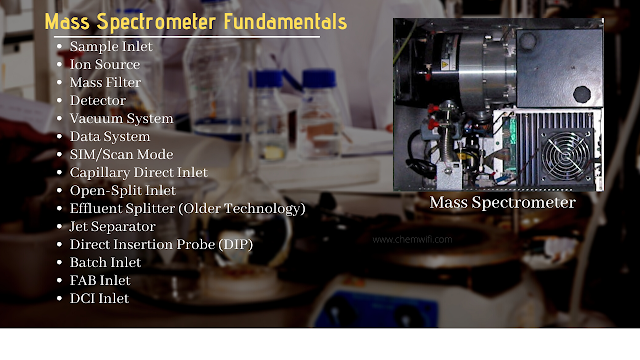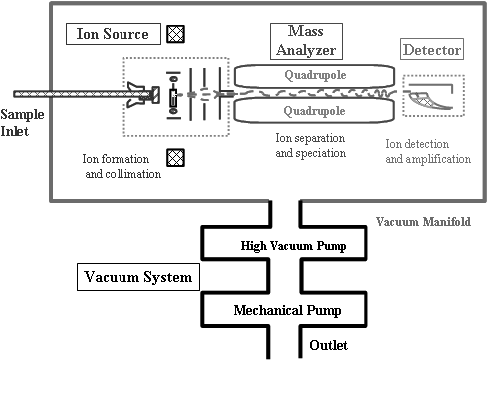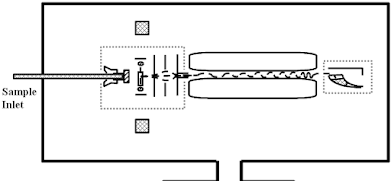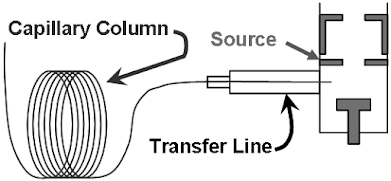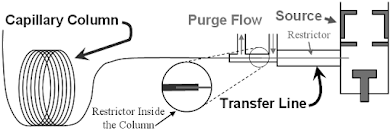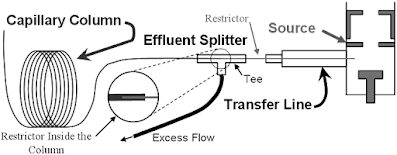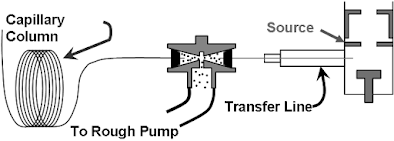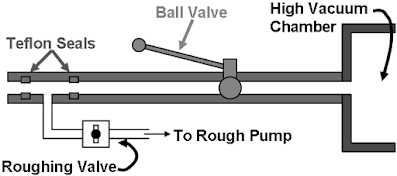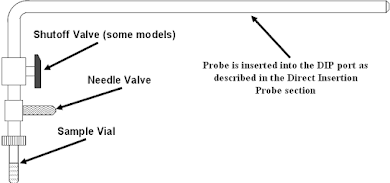Mass Spectrometer Gas Chromatography Fundamentals
Sample Inlet
Gas, liquid and solid compounds can be introduced into the ion source through specially designed inlets with controlled flow. This can be done a number of ways depending on the state of the sample. Several of the common types of sample inlets are:
• GC
• LC
• Direct Insertion Probe
• Batch
Ion Source
Sample molecules are introduced into the ion source through the sample inlet. Before the mass spectrometer can analyze a sample, it is necessary that the sample molecule be ionized. One method used to ionize and fragment the sample is to bombard the molecules with electrons. This results in different fragmentation patterns which can be used to identify the sample compound.
The filament is the source of electrons. A repeller is used to help direct ions through a series of lenses in the ion source. Without these components, sample molecules would not be ionized and they would not reach the mass filter.
The fragmentation process which occurs in the ion source is important because the results are ultimately used to identify species. The other parts of the mass spectrometer, the mass filter and detector, are used to select and count ions.
Two common types of ionization are electron ionization and chemical ionization.
The ion source is used to:
• Fragment and ionize sample molecules.
• Direct ions through a series of lenses into the mass filter.
Mass Filter
Once ionized, the ions enter the mass filter. The mass analyzer moves selected ions from the ion source to the detector. The mass analyzer filters and separates ions based on their mass to charge ratio. Only an ion of one mass is passed through the mass filter at a given time.
Several common mechanisms or methods are used to select and filter these ions. Four common types of mass analyzers which separate ions by their mass to charge ratio are:
• Magnetic Sector
• Quadrupole
• Ion Trap
• Time-of-Flight (TOF)
The mass filter is used to:
• Move ions from the ion source to the detector.
• Filter ions according to their mass to charge ratio.
Detector
Once an ionized sample has been filtered by mass-to-charge ratio in the mass filter, the abundance must be detected and reported to the data system. A detector is used to collect and count ions. Only one ion is detected at a given time, whether the mass filter is a time-of-flight, separation by space, quadrupole filter or ion trap.
Once inside the detector, the ions generate a signal which can be displayed by the data system.
The detector is used to:
• Count ions.
• Generate an electrical signal.
Vacuum System
The ion source, mass filter and detector are in a vacuum. The vacuum system makes it possible for ions to move from the ion source to the detector without colliding with other ions, sample molecules, air and water.
A vacuum is created by removing all species from the mass spectrometer. Minimizing collisions with other ions ensures that more ions will be counted by the detector.
The vacuum system is used to:
• Provide ions with a free path of travel from the ion source to the detector.
• Remove all species from the instrument.
Data System
The data system has three purposes:
• Controls the operational parameters of the ion source, mass filter and detector.
• Graphically displays the results of the sample compound as a mass spectrum.
• Manipulates data for identification and quantitation.
The data system is used to:
• Control the mass spectrometer hardware.
• Collect data and display it in a useful way.
• Integrate data to produce reports.
Sample Inlet
Purpose of the Sample Inlet
Before a sample can be analyzed by the Mass Spectrometer, it must reach the ion source and be ionized. The sample must be vaporized so molecules can be separated from each other.
This seemingly simple task is complicated by the billion-fold pressure differential between the source and the outside world. The sample introduction devices must therefore serve three
purposes:
-
Place of entry
-
Transports the sample to the source
-
Preserves the vacuum within the Mass Spectrometer
SIM mode
Scan mode
SIM/Scan
What is a Capillary Direct Inlet?
Capillary Direct Advantages
-
simple
-
all sample goes to the Mass Spectrometer
-
best GC sensitivity
Capillary Direct Disadvantages
-
cross-linked columns only
-
retention time may be off due to vacuum effects
-
MS dependent
-
everything injected enters the ion source
Open-Split Inlet (Older Technology)
What is an Open-Split Inlet?
Open-Split Inlet Advantages
- accommodates wide-bore or narrow-bore columns
- no need to vent to change columns
- no vacuum effects on chromatography or retention time
Open-Split Inlet Disadvantages
- sample is split – only allows a small portion of the sample to enter the mass spectrometer
- more flows to set
- more places to leak
- a plug can occur in the restrictor
- split ratio is slightly temperature dependent
Effluent Splitter (Older Technology)
What is an Effluent Splitter?
Effluent Splitter Inlet Advantages
-
accommodates wide-bore or narrow-bore columns
-
no need to vent to change columns
-
no vacuum effects on chromatography or retention time
Effluent Splitter Inlet Disadvantages
-
sample is split – only allows a small portion of the sample to enter the mass spectrometer
-
more places to leak
-
a plug can occur in the restrictor
-
split ratio is slightly temperature dependent
Jet Separator
What is a Jet Separator?
Jet Separator Advantages
- temperature independent
Jet Separator Disadvantages
- discriminates against low molecular weight compounds
- easily clogged
- easily mechanically misaligned, if mishandled
Direct Insertion Probe
What is a Direct Insertion Probe (DIP)?
Direct Insertion Probe Advantages
- Allows spectra of relatively nonvolatile compounds to be obtained
-
minimum sample preparation
Direct Insertion Probe Disadvantages
-
samples must be relatively pure
-
requires a valving system
Batch Inlet
What is a Batch Inlet?
Batch Inlet Advantages
-
allows spectra of more volatile compounds to be obtained
-
minimum sample preparation
Batch Inlet Disadvantages
-
samples must be relatively pure
-
requires a valving system
FAB Inlet
What is a Fast Atom Bombardment Gun?
The FAB technique is a process which:
- Generates high energy ions and atoms.
- Focuses those ions and atoms through the gun onto a liquid surface.
- Induces secondary ions from the liquid surface.
FAB Advantages
- excellent technique for analysis of peptides
- good for nonvolatile compounds.
FAB Disadvantages
- static introduction of samples requires pure sample
- slow process which gives low sample throughput
- high noise background
- contaminates ion source quickly
DCI Inlet
What is a Desorption Chemical Ionization Inlet?
This process differs from performing chemical ionization analysis using a DIP in the rate at which the sample is directly heated. By heating the sample rapidly, thermal degradation is minimized in DCI.
